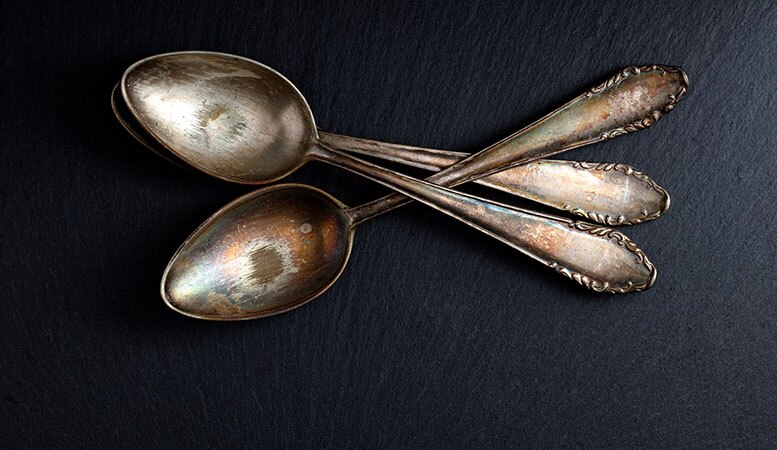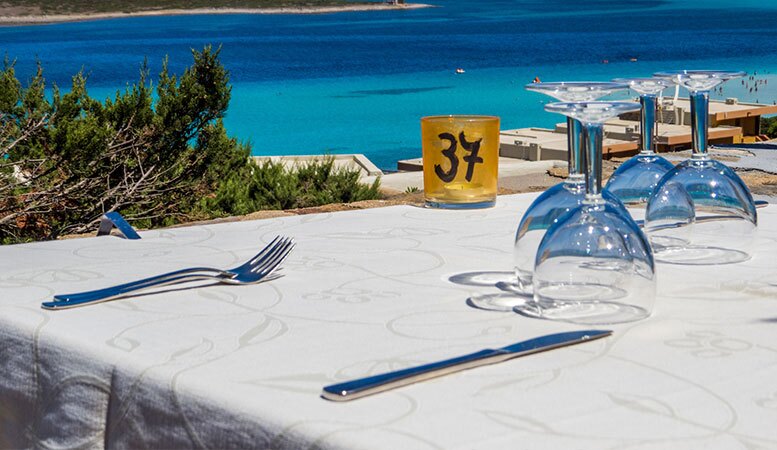Silver is one of the most popular materials used in fine jewelry, including wedding rings, necklaces, and other accessories. It’s also commonly sold in bars that people keep for decades in vaults and safe deposit boxes. Most people view silver as a long-term investment, so they’d like to keep it in pristine condition for as long as possible.
However, many first-time buyers are surprised when they find that their precious silver accessories, once shiny and beautiful, have blackened or are starting to show signs of rust. Nobody wants to see this happen, especially when their silver bullion bars are up for appraisal.
In this brief explainer, we’re going to clarify: Does sterling silver rust and tarnish? And if so, how do you keep it from happening? You’ll also learn a few tried and tested tricks for keeping your silver jewelry and accessories looking polished and brand new for a long time.
What Is Sterling Silver?
To know whether true silver rusts and tarnishes, first, you have to understand the difference between pure silver and sterling silver. Jewelers use these two terms interchangeably to refer to accessories made from genuine silver. However, first-time buyers might be surprised to find their sterling silver earrings, bracelets, and brooches darkening over time.
A sterling silver ring and a pure silver ring have different compositions, lifespans, care techniques, and prices. While they are both genuine silver, which will offer the shine and glamor that most people look for in jewelry, they have different chemical make-ups.
Pure Silver
Pure silver bars and accessories are 99.9% silver, with only trace amounts of other minerals or metals. Much like gold, pure silver is soft and extremely malleable, which makes it inefficient as a wearable item. If you throw a pure silver bar onto a wall, you will find it bent and disfigured on the ground.
Many items that say pure silver on the label are a combination of silver and other metals that help it keep its shape, firmness, and shine. 99.9% silver denotes the finest of fine jewelry, and these pieces require a somewhat lower amount of maintenance but more caution when wearing them.
Pure silver is notorious for tarnishing. Unlike gold or platinum, silver is highly reactive to moisture and minerals in the air, which can cause it to darken, fade, and discolor. Pure silver bars are commonly stamped with a “99.9” or “.999” at the jeweler’s, indicating that it’s not combined with any other metal, and you should be extra careful when handling it.
Sterling Silver
If pure silver is 99.9% pure, then it stands to reason that sterling silver is somehow more adulterated, which is true to a degree.
Sterling silver is a metal alloy. If you’re new to buying precious metals, an alloy is a metal that’s infused with another metal to make it more suitable for use in everyday life. If you wear a wedding ring that’s 99.9% gold, you’d have to take it off whenever you’re assembling a new computer or fishing stuff out of the couch because pure gold is malleable and easily bent.
Calling an accessory “sterling silver” means it has 92.5% silver content, alloyed with 7.5% zinc or copper. Pure silver household accessories are rare, but it won’t be hard to find sterling silver platters, plates, and coffee sets, along with forks, spoons, and knives, in fine restaurants.
Sterling silver is more rigid than pure silver, but it tarnishes more easily. Minerals like zinc, nickel, and copper are highly reactive to moisture and pollution, and when you combine them with silver, the process of tarnishing will accelerate. Sterling silver bars, jewelry, and other items usually have a stamp of “9.25,” “925,” or “SS” that indicates their level of purity.
Silver-Plated
Silver accessories have three general levels of purity: pure, sterling, and silver-plated. Sterling is still arguably pure silver that’s watered down a tad for practical use. Silver-plated items, however, are made from an entirely different type of metal with a sterling silver coating.
For example, musicians love the sound of silver-plated guitar strings because they produce a warmer tone than bare steel and silk. Silver-plated strings are commonly copper and steel, which are coated in silver to create a rich, jazzy sound when strummed that café players appreciate.
Silver-plated accessories are prone to the same discoloration and tarnishing that pure and sterling silver items experience. To prevent this, jewelers and silversmiths have developed a workaround in which they coat silver plating with a flash-melted white metal. The coating will keep your jewelry and silverware tarnish-free, but less so with every polishing. You can get your items re-plated when black marks start to form.
Does Sterling Silver Rust?

Most precious metals are immune to corrosion, and that includes gold, silver, and bronze. Rust occurs when a steel surface reacts to water, either directly dripping on it or present in the air, which oxidizes iron molecules and turns them into orange-brown wafers that eventually become flakes.
However, when talking about gold, silver, and bronze jewelry with no iron alloys, rust occurs in the form of tarnishing. Your sterling silver items will not oxidize and turn orange-brown, but they will darken, discolor, and form a black coat on their top layer. This coat is easily removable with a silver polishing cream.
As long as your silver bars don’t have an iron alloy, they will never rust, and if they do, the rust will only eat up the iron and leave the silver alone. Most sterling silverware, jewelry, and bars have bronze, copper, and brass alloys, which do not rust but react to oxygen by creating a sea-green patina that prevents them from further oxidizing.
How to Clean Your Silver
If you have silver items that you suspect are rusting, then good news: You can restore them to their former glory with just a little bit of cleaning. You’ll need four items to clean your silver:
- A microfiber cloth
- A silver cleaning mixture
- A beaker or a clear glass
- Aluminum foil
Making Your Cleaning Solution
Some people believe that toothpaste is enough to clean the patina off your silver items, and that was true a few decades ago. However, modern toothpaste has so many additives, like acids, whiteners, and breath fresheners, that it might be too abrasive for your silver jewelry. You’re better off using a cleaning product specifically designed for sterling silver or making your own silver cleaning solution.
To remove rust or tarnish from sterling silver, follow the steps below:
- Use foil to cover the inner area of your beaker or glass.
- Add two tablespoons of baking soda and salt, then add some hot water.
- Soak your silver items in the solution for five to 10 minutes.
- Retrieve them and wipe off the residue with your microfiber cloth.
How to Stop Your Sterling Silver from Tarnishing

When your sterling silver items tarnish, it means you’re most likely using them in everyday life and getting your money’s worth. So don’t fret over an easily-removable black coating. Tarnishing is inevitable even if you keep them in a locked up vault 24/7.
However, there are a few tricks that you can use to delay tarnishing with minimal effort, especially if you’re someone who’s just learning to take care of new jewelry.
Keep It Out of the Ocean
Silver, copper, and bronze are highly reactive to saltwater, which is why a combination of baking soda, hot water, and salt makes the solution that many jewelers use to clean them.
To keep the luster of your sterling silver, stay out of the ocean and avoid handling abrasive cleaning products while wearing sterling silver jewelry. You can shower with your silver jewelry on, but most soaps are made of solidified potassium salts, which can cause your silver jewelry to tarnish.
Check Your Wearing Habits
Before wearing jewelry, put on your perfume, make-up, and hair products so that you’re ready to leave when you have them on. The chemicals and oils in astringents, hairsprays, and sweat can cause your sterling silver to tarnish, which means you should put on your accessories last and remove them first after returning home.
Are Your Home and Workplace a Conducive Place for Jewelry?
If you live by the ocean or any other body of saltwater, the air will naturally be more saturated with moisture and salt compared to areas in the mountains or the city. Unless you keep your sterling silver in an airtight container, it will tarnish quicker, which is also true for city-dwellers who live in an environment with a lot of pollution.
Sulfur in the air can cause your sterling silver to tarnish in a matter of minutes. If you live in a volcanic area or a place where there’s always a lot of smog, expect your silverware to turn dark from just a few months’ use. An excellent way to counter this is to cut off your silverware’s exposure to moisture and air.
If you don’t have an airtight organizer, get a Ziploc bag and check it for airtightness. Put your sterling silver inside with a few silica gel bags, which should absorb the possible rise in humidity due to changes in outside temperature.
Curious About Silver?
Silver is a highly sought-after item, and you’d be hard-pressed to find anyone in the world who doesn’t want a piece. People have been using silver as currency and as an asset for upwards of 4,000 years.
If you’re curious about investing in silver or how to take better care of the silver pieces you already have, contact the Oxford Gold Group today by dialing (833) 600-GOLD or (833) 600-4653. They have investment professionals and silver experts on standby, as well as a wealth of information on other precious metals. From questions such as “Does sterling silver rust?” to advice on investing in precious metals, their experts are here to assist you.








